
All cards may have the following components: affiliation, color, type, title, ability, uniqueness, flavor, identification, rarity, and dice reference.
-
Affiliation
There are three different affiliations: hero, villain, and neutral. The affiliation of each card is written on the bottom of the card.
-
Colors
Each card is associated with a specific color and is written on the bottom of the card.
Red is Command, and represents military and logistical endeavors and characters.
Blue is Force, and represents characters trained in using the Force and their varied abilities.
Yellow is Rogue, and represents scum, villainy, spies, and smugglers.
Gray is General, and represents everything that does not fall under one of the other three colors.
-
Type & Subtype
Each card is one of six types: battlefield, character, event, upgrade, support, or plot. The type is listed above a card's abilities, except on battlefields, where it does not appear. Some cards have one or more subtypes listed after the type.
-
Title
A card's title is used to identify and describe what it represents in the Star Wars universe.
-
Abilities
Most cards have one or more abilities listed on them.
-
Uniqueness
Each card is either unique or non-unique. Unique cards are marked by a diamond before their titles. All other cards are non-unique.
A player cannot have more than one copy of a unique card in play at the same time. There cannot be more than one copy of a unique character on a team, and a player cannot play a unique support or unique upgrade if they already have another copy of that card in play.
The unique restriction applies to each player individually. Players can each have one copy of a unique card in play at the same time.
If a player ever controls more than one copy of a unique card, then they must immediately discard one of those cards from play.
The unique restriction does not apply to dice. A player can have multiples of the same die in play at the same time.
Characters with the same title but a different subtitle are still considered to be the same character for determining uniqueness.
-
Flavor
Flavor text has no in-game application when present.
-
Identification (ID)
A card's identification contains the set symbol (Awakenings' set symbol is r) followed by a number. These help identify the cards and match them to dice.
-
Rarity
There are five levels of rarity. The rarity of a card is shown by a color behind the collector's info. A die that comes with a card shares its rarity with that card.
 Fixed (Gray): Fixed cards have a non-random distribution and always come in the same product.
Fixed (Gray): Fixed cards have a non-random distribution and always come in the same product. Common (Blue): There are three common cards per booster pack.
Common (Blue): There are three common cards per booster pack. Uncommon (Yellow): There is one uncommon card per booster pack.
Uncommon (Yellow): There is one uncommon card per booster pack. Rare (Green): There is one rare card and its matching die per booster pack.
Rare (Green): There is one rare card and its matching die per booster pack. Legendary (Purple): One in six booster packs has its rare card and die replaced by a legendary card and its die.
Legendary (Purple): One in six booster packs has its rare card and die replaced by a legendary card and its die.
-
Ice Reference
A card that comes with a die has reference boxes that show all six sides of that die.
Card Anatomy
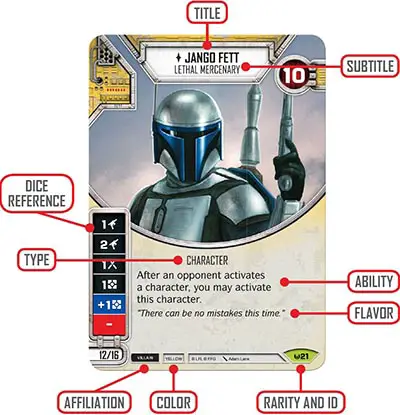
Battlefields
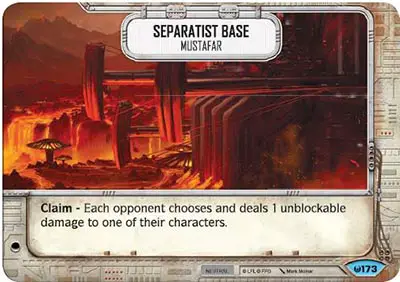
Battlefields represent various locations that players face off in. One battlefield is chosen at the beginning of the game, and the other battlefield is not used.
One player at a time controls the battlefield, and places it next to their deck, either because they started the game with it or were the last person to claim it.
Battlefields may have claim abilities on them. These abilities may be resolved when the Claim the Battlefield action is taken.
The player who controls the battlefield takes the first action each round.
All battlefields are considered to be Gray.
Subtitle (also appears on Characters)
A subtitle defines the location or planet of a battlefield, and helps distinguish different versions of characters from each other.
Plots
Plots represent various schemes and strategies that players can begin the game with.
Players may optionally select one plot (but no more than one) when building their team. Each plot has a point value that counts toward the 30 point limit, just like characters. Plots start the game in play and remain in play.
A hero or villain plot can only be selected if there is a character of that affiliation on a player's team. A Blue, Red, or Yellow plot can only be selected if there is a character of that color on a player's team.

Point Value
A card's point value is how many points it costs to include it on a team.
Characters
Characters represent notable individuals in the Star Wars universe. Each player spends up to 30 points on characters during customization. Characters start the game in play and remain in play until defeated. Each character has one or two dice that are rolled when that character is activated.
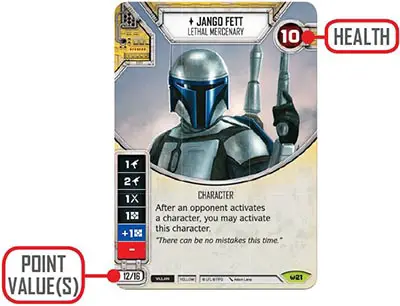
Health
A character's health is how much damage it can take before being defeated.
Point Value(s)
A character's point value(s) is how many points it costs to include it on a team. If there are two values, then the smaller value is how many points it costs to use one of that character's dice, and the larger value is how many points it costs to use two of that die. A character with two of its dice is called an elite character.
Events
Events represent tactical actions, schemes, twists of fate, and other unexpected developments that might occur during the game.
When a player plays an event, they follow the card's instructions and then discard it to their discard pile.
When an event is played, it is considered to be in limbo until it is fully resolved.
Provided any play restrictions are met, a player can play an event even if the event has no effect.
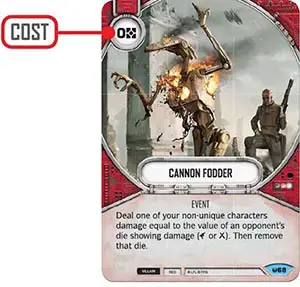
Cost (also appears on supports and upgrades)
The cost of a card is listed in the upper-left hand corner of the card. A player must spend resources equal to the cost of a card in order to play it.
Supports
Support cards represent various vehicles, connections, and forms of logistical aid. When a player plays a support card, they place it faceup in their play area, next to or behind their characters.Supports have repeatable or ongoing effects and stay in play unless an effect or ability discards them.
- Support cards cannot take damage.
- If a support has a die, that die is rolled when the support is activated.
- There is no limit to the number of supports a player can have.
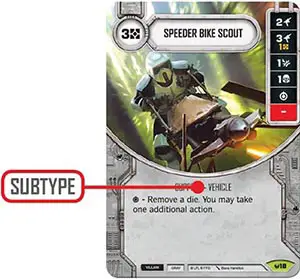
Subtypes (also appears on characters and upgrades)
Some cards have subtypes listed after the card's type, such as "Vehicle" or "Weapon". Subtypes have no inherent rules associated with them, but other cards may reference them.
When a card refers to a subtype in its text, the subtype is bold.
Upgrades
Upgrades represent weapons, gear, and abilities that characters have at their disposal. When a player plays an upgrade, they attach it faceup to one of their characters. Upgrades have repeatable or ongoing abilities and stay in play unless an effect or ability discards them, or the character they are attached to is defeated.
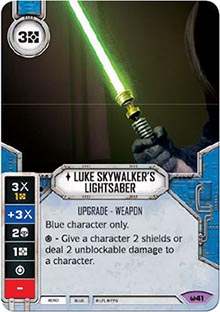
A player may discard an upgrade already on a character to decrease the cost of a new upgrade being played on that character by the cost of the discarded one. This is called "replacing an upgrade" and each player can only do this once per round.
Each character cannot have more than 3 upgrades. If a character ever has more than 3 upgrades, the player who controls it must choose and discard upgrades from it until it only has 3.
(A player can play an upgrade on a character with 3 upgrades and then discard one. This is not the same as replacing an upgrade, and the cost of the new upgrade is not decreased).The color of a character and its upgrades do not have to match. A character can have an upgrade that does not match its color, provided all deckbuilding and play restrictions were followed.
There is no limit to the number of weapons , equipment , or abilities a character can have as part of its 3 upgrades.
A character can have multiple copies of the same non-unique upgrade.
If an upgrade has a die, that die is rolled when the attached character is activated. It does not matter if the upgrade is ready or exhausted, and the upgrade does not exhaust along with the character.
Continue Reading


